Hue Citadel
As Hue had been Vietnam’s capital for an extended period of time there are also some remainders of the rule of the Ngyuen Dynasty right within the city. And only this day (11-AUG), the day of my leaving in the afternoon, I found the time to visit them.
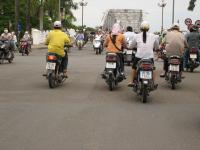
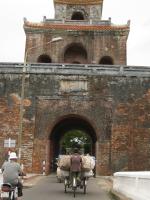
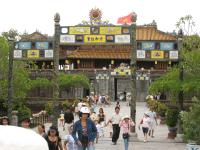
HU_20070811_093857.jpg: To make things easier I the first time got into one of the pedicabs, a 3-wheeled bicycle for passenger transport. Being cycled in the center of Hue’s strets provides you with this kind of view on Hue’s traffic. By far not as bad as Hanoi’s traffic, but you’ll get the idea: Motorcycles everywhere.
HU_20070811_094640.jpg: There is an outer citadel and an inner one. You can probably think of the outer wall as kind of a city wall, while the inner one circumfences the emporer’s palace, not unlike Beijing’s Forbidden City. Here we cycle through a gate of the outer wall with another pdeicab in front us, used her to transport goods, which I saw quite frequently in Hue and occasinally also in other places.
HU_20070811_095722.jpg: After entering the inner citadel a look back through various gates, which all look Chinese with their Chinese inscriptions. And here lots of tourists as this is the main attraction of Hue proper.
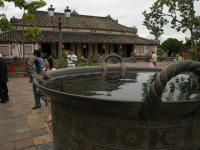
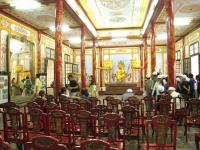
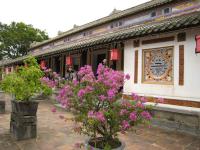
HU_20070811_100514.jpg: A caldron in the foreground filled with (rain?) water. I know from China that these huge bronze vessels provide water for fire fighting. But they also just make a nice decoration.
HU_20070811_100713.jpg: Inside view of the building in above picture’s background: There are two halls to both sides of the square, used in former times for the officials to prepare for audiences with the emporer. Today a tourist trap with the possibility to take on ancient-style clothes and be photographed in an important looking chair in front like one guy just now. I have my doubts if that chair is original as the hall should be for meeting preparation, not for somebody to preside over an audience. But the Chinese tourists love it anyway like at home 😉
HU_20070811_101640.jpg: The preparation hall at the square’s opposite side.
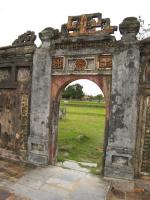
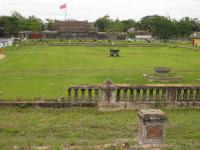
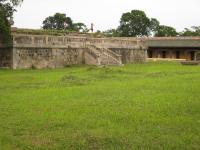
HU_20070811_101950.jpg: The Forbidden Purple City, reserved solely for the emporer’s use. You’ll note the similarity in naming with Beijing’s Forbidden City.
HU_20070811_103515.jpg: There isn’t much left, though, destroyed completely during the Tet Offensive. (It is generally quite sad to hear that many relics have only been destroyed in the most recent war, also see My Son later, visited from Hoi An.) This view is from the far side of the ‘city’, with the gate shown in the previous picture being to the right of the remainders of the wall in the far back. And you’ll note its emptyness. Most tourists stayd outside this grassy area, which gave the few non-guided tourists like me some minutes of undisturbed exploration.
HU_20070811_102141.jpg: Looking eastern from the Purple City some more remainders of something. Here me Lonely Planet got me confused…it said something about a restored reading room, but I was unable to locate it.
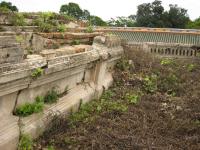
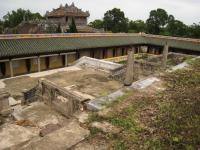
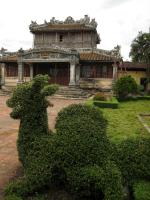
HU_20070811_102322.jpg: Atop this broken building seen in the previous picture. It is really quite tattered. But again, this makes things more authentic and you’ll get the feeling to walk on history. Surprising how little the impact of the tourists is.
HU_20070811_102443.jpg: Same place, looking a bit deeper into the site. Somebody, however, seems to get up regularly to this flat top and cut the grass 😉
HU_20070811_102743.jpg: Another old building, looks also quite authentic. Maybe that’s the reading room…but no access to figure it out for sure. Watch the bush in front, cut in the shape of some fantasy animal.
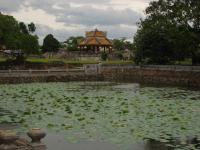
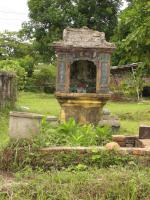
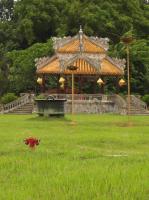
HU_20070811_102855.jpg: Behind the above building is this pond full of water lilies. And in the far back a pavillion. Just a very nice view, isn’t it?
HU_20070811_104154.jpg: Probably original, too, this small altar. Sits pretty alone somewhere on the meadow. But some locals still burn incense sticks there. You’ll never know…better be good to the gods 😉
HU_20070811_104415.jpg: Modern vs old fire-fighting technology: A modern red hydrant looks through the grass, in the back one of the old caldrons in front of the same pavillion as two pictures earlier.
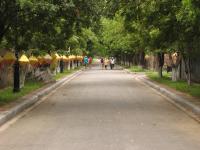
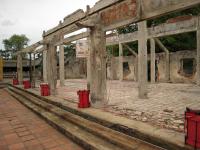
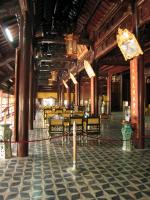
HU_20070811_104721.jpg: The entire site was quite large. Some streets have been modernised like this one. And the lampions…
HU_20070811_104931.jpg: …guide you to a Palace-by-night event, which I unfortunately did not see as I left the same afternoon. Could look quite nice, I’d assume.
HU_20070811_105104.jpg: Main hall of the Dien Tho Residence, another large complex within the inner citadel and formerly the living quaters for the Queen Mothers.
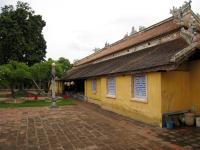
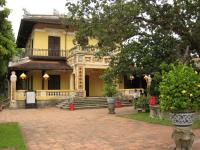
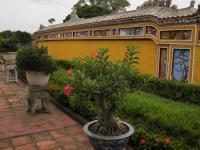
HU_20070811_105525.jpg: A back yard of Dien Tho Residence.
HU_20070811_110008.jpg: A ‘small’ side building of that residence, the Tinh Minh Building. Not sure about its original purpose, but later became a clinic for the empresses. And after the dynasy’s fall the private residence of president Bao Dai. Not bad a place to live in…weren’t there so many tourists. But I believe he has moved out since then 😉
HU_20070811_110128.jpg: A screeb wall shielding the views from the main entrance to the residential complex, together with some bonsais. Bonsais seem to be quite popular in Vietnam. I see them everywhere, especially at historical sites.
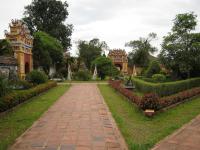
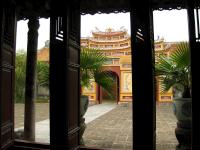
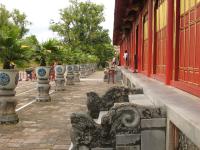
HU_20070811_110654.jpg: Garden view of the Mieu and Hung Mieu Compund. Again I managed to come in via a back entrance…
HU_20070811_110822.jpg: Looking from one of the building of that compund out on an inside gate. These screen doors I have seen note only quite often in Vietnam, but especially also in south-west China. See LiJiang for example.
HU_20070811_111103.jpg: The main hall of that compound, seen from the side. This is a renovated building, not authentic. It houses altars for nine past emporers.
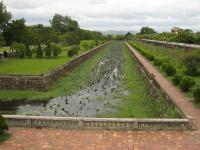
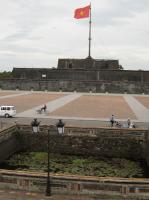
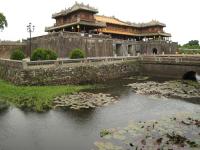
HU_20070811_112105.jpg: View from the citadel’s main gate along the surrounding moat. Again…water lilies 😉
HU_20070811_112132.jpg: From that same main gate looking out over the square in front onto the huge flag pole with the ubiquious Vietnamese flag.
HU_20070811_112434.jpg: Eh…yea…this is the main gate I kept talking about.
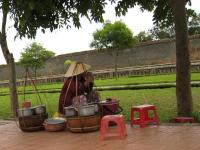
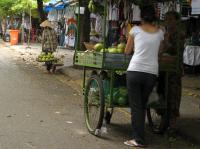
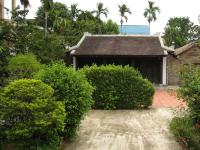
HU_20070811_113121.jpg: ‘My’ pedicab driver hat waited all the time for me (more than 1.5 hours) in hope for more business. He suggested a drive around the inner citadel and so we did. This lady selling some food sat in the shadow of the trees along the street surrounding the citadel. The citadel’s walls are visible in the back.
HU_20070811_113754.jpg: Market street somewhere in the citadel’s surroundings.
HU_20070811_113952.jpg: Ho Chi Minh’s residence. He seems to have lived in all cities of Vietnam at some point in time, nearly all cities I’ve seen have a Ho Chi Minh residence. Hue claims that he lived in this rather unremarkable house between 1895 and 1901. It was not accessible, at least not at the time we passed by, so this is just a shot over the fence.
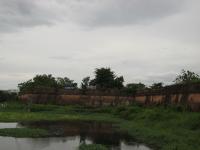
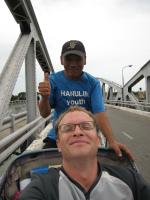
HU_20070811_114337.jpg: We eventually left also the outer citadel, this time via a different gate. Here a look back at its quite massive walls and large moat.
HU_20070811_115430.jpg: My driver and I, while crossing a bridge over the Perfume River. Apparently he was used to this kind of self-portraits 😉 And he ripped me off in the end…partly my own fault certainly as in all cases of rip offs: I had agreed on 30,000 Dong to bring me to the citadel. I had not negotiated a price for driving around and bringing me back. In the end he wanted to see a stunning 120,000 Dong in total! So be warned…waiting for you without yet being paid does not mean that further transportation is included in the original price.
I had a quick lunch and got the first time on an Open Tour bus. These Open Tours are a very simple way of getting up and down (‘around’ would be the wrong word in Vietnam due to its geography ;)). The idea is you buy a set of tickets upfront for individual sections between a number of cities, which in combination bring you all the way down from Hanoi to Saigon (or certainly the other way round), for an unbeatable price. But as so often: You get what you pay for. Originally invented by the Sinh Cafe it became largely popular and nowadays several companies offer Open Tours. The big competition has reduced prices to an unbeatable level. But as so often: You get what you pay for.
I found my first Open Bus trip partly annoying: It’s OK that it takes quite some time (an hour) to pick up all people from the various hotels in town. I had walked up to the travel agency’s office, just around the corner from my hotel, which provided me with a good seat as I was one of the first ones to enter the bus. I was not surprised that the bus was full in the end. But in the next small town we picked up even more people, some of them were required to sit on chairs in the aisle. Well…you can endure that for the 4 hours between Hue and Hoi An, but I don’t want to think about what it means if it happens to an 12-hour-overnight tour, for example between Hoi An and Nha Trang.
There was a group of ‘funny’ Dutch on the bus with rather low-level jokes, which added to me being annoyed, but iPod and a book helps blocking that out. The next major annoying thing was that we had to switch busses in the middle of the trip. Don’t ask me why. But the people travelling north had to get into our bus; and we, heading south, changed over to their bus. With all luggage. You can imagine that this produced quite some chaos and delay.
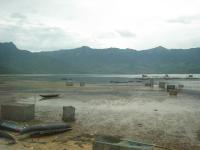
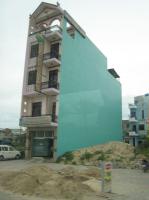
HU_20070811_163135.jpg: Some inner(!) lake of Vietnam, close to the place were we had switched busses, photographed out of the bus. Could be a nice picture, but is a bit flat due to the busses window being in the way.
HU_20070811_171017.jpg: Educational picture: Not sure if you noted from my reports that many houses in Vietnam are very narrow. This one, a perfectly finished and operated hotel somewhere in Danang, is a good example, that even nowadays and even if there is enough room, people like to build rather narrow and high. I somewhere had picked up that the reason for this weird style are taxes: Houses seem to be taxed according to how much space they occupy along the street.
Arriving in Hoi An the bus actually drove through the main hotel streets, but stopped only at the travel agency, which happened to be far out of town, and having a hotel next to it. I was not so silly to get into that hotel. I had no reservation, but some places in mind I wanted to check out. Hoi An seems to be a place for hotels with pools, and I wanted to have such one. End of guest houses…hotels are affordable here, too. So I jumped on a motorbike with both my bags and had the driver get back to the main street of hotels. To make it easier I gave him the address of the first hotel to check. When we arrived there the driver told me it’s full. That is a common scam and you’d better ignore it: They only want to guide you to ‘their’ hotel. I paid him and got off. But apparently he was right this time: Not only was this hotel full, but also all other places I had in mind along the street, and on top of that all places I had not in mind but came across.
Rather desperate now, I hired another motorbike to bring me to another area of hotels in the city, but no success either. Uups….Lonely Planet had said there once were too few hotels during high season, but that had changed during a building boom and nowadays even discounts would be doable during high season. Forget it…tourists were faster than the building boom. Finally this second motorbike driver came up with ‘his’ hotel and a flyer of it. I was certainly sceptical, but also desperate. Without even looking at the flyer I signalled OK. He was so smart to have a receptionist of the hotel we checked last call ‘his’ place and, surprise, surprise, they still had one room. OK, hurry…let’s get there! I was already fearing the worst as the ride was a bit away from old town Hoi An, but…
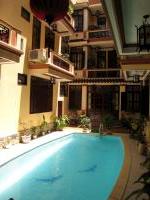
HA_20070812_105109.jpg: And surprise, surprise! This Ninh Ninh Hotel is definitely worth a very warm recommendation! It has very friendly people, who try to read every wish from your lips before you had even time to think about it. There room was large, nicely furbished, the bathroom spotless. And all that for just 15 USD per day! (Plus 2 USD for breakfast, which I managed to haggle down to 1 😉 a good deed, as the breakfast is one dish plus one drink out of about 15 choices each, so by no means really filling.)
And, best of all: There was a pool, with a young Irish lady swimming in it. So the first thing I did was a quick shower and then jumping into the pool. No, what do you think again??? Not because of the Irish lady, because of the pure existence of the pool, certainly! The pure presence of the Irish lady by the unusual name of Ursula, however, led to yet another nice evening in company, during which we came up with an itinerary for her to visit BeiJing and Lhasa by train, starting from Hanoi. Well…in the end, two days later, she had to decide she couldn’t do it…but it was a pleasant evening nonetheless.
Which, however, meant that I again had no time for web site updates. You simply meet too many people here…
Today’s Lesson: You should know it: Negotiate all services before usage.
Categories: AsiaHue
Originally Created: 08/15/2007 08:41:57 AM
Last Edited: 08/15/2007